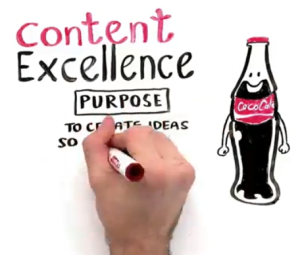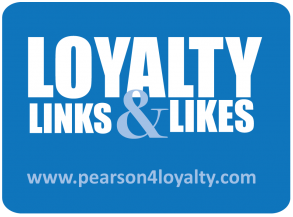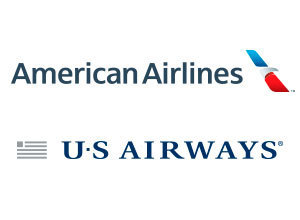Bryan Pearson's Blog, page 49
March 18, 2013
Putting “The Real Thing” on Paper: Learning from Coca-Cola’s Liquid Ideas

Source: Coca-Cola
If you were to open a picture book that told your brand story, what do you envision would be on the pages?
For Coca-Cola United Kingdom, the answer exists not so much in a curved bottle of sweet liquid, but in actual liquid ideas – stories that represent so much value in people’s lives that they become part of our culture.
Coca-Cola describes this new concept, and mission, in a two-part video called “Content 20/20.” Illustrated across 10 chapters, the 18-minute presentation details how Coca-Cola intends to evolve from its existing status of creative excellence to a new ideal of content excellence.
As the narrator puts it: “Through the stories we tell, we will provoke conversations and earn a disproportionate share of popular culture.”
The video builds on the concept that storytelling adds another component to the dialog process, and an incredibly fertile component at that. The purpose of the mission, as described in the video, is to develop deeper brand connections through storytelling. Doing this means creating brand stories that generate liquid ideas so contagious they get people talking, and influence positive change. The result is a unified and coordinated brand experience across multiple channels.
Remember, the narrator explains – storytelling is at the heart of all families, communities and cultures.
And from where do these stories originate? Data will become the “new soil, soil in which our ideas will grow, and data whisperers will become new messiahs.”
In other words, by leveraging the customized content consumers share, we have the ability to create messages and stories that are relevant for specific customers, based on their profiles.
Coke’s “Content 20/20” mission provides a telling glimpse into where the world is headed with respect to traditional media communications vs. storytelling and generated content. A brand that has long mastered the deft technique of connecting with consumers through emotional relevance, Coca-Cola is raising the bar for all brands.
So sharpen your pencils. If your brand was a picture book, what would it say on page one?
March 13, 2013
March 13: Loyalty Links & Likes
 Here are a few loyalty links that caught my eye this week.
Here are a few loyalty links that caught my eye this week.
1. Why Starbucks’ Customer Loyalty Is More Lucrative Than Any Ad Campaign — brandchannel
The story includes a few lines from a book by Starbucks’ CEO in which he writes, “Starbucks never set out to be cool. We set out to be relevant!”
2. 70% of Consumers Worry About Loyalty Program Privacy — Marketing Pilgrim
The author cites a new report that touches on consumers’ concerns about their personal information.
3. The Gift of Showrooming — COLLOQUY
How the latest retail trend can actually benefit businesses and boost loyalty.
4. Auto buyers trading in loyalty for lure of new models — The Detroit News
This story offers a look into loyalty’s worth in the auto industry.
5. When Customer Service Isn’t Even Half-Baked — The New York Times
Here’s another case of bad customer service leading to losing customer loyalty.
March 11, 2013
Social Physics 101: How Data Defines Us

Source: DatabaseGuides
In a country where all men and women are created equal, data may prove to be the great differentiator.
This is what is implied with the concept of “Data-Driven Societies,” as recently explained in a compelling story in The New York Times. The report details a gathering of academics, business executives and journalists who assembled in mid-February to mull over this concept, and what it could mean for public policy.
Leading the group was Alex Pentland, a computational social scientist at the Media Lab. Pentland authored a presentation called “Reinventing Society in the Wake of Big Data.” His theory: That the most valuable data available today is that which analyzes people’s behavior.
The reason, in part, is because such information is vast and highly detailed. Consumers use their credit cards to buy items as small as a cup of coffee, while all day long location-tracking technology in their smart phones follows them from location to location.
It has, according to the NYT story, become possible to track social phenomena down to the individual level and to gauge the social and economic connections among individuals. Pentland said the ability to follow these micro-patterns indicates our culture is entering an era of “social physics.”
Using the term, “social physics,” to describe the use of transaction data really resonates. The idea that different customers could be treated in varying ways based on their consumption is something social policy may need to accept. In the context of the NYT story, the thought was applied to government incentive and benefits programs, such as tax credits for solar panels or Social Security. But “social physics” is already taking place among the more advanced merchants and financial services companies, which have figured out how to encourage and reward individuals based on what they purchase, where and how often.
Policy makers should look to these experts for some pointers.
Another statement from the story that caught my eye up involved the fact that algorithms, which determine the patterns and insights that guide decision-making, are in fact created by people and therefore susceptible to human assumptions. “At some point, you are in the hands of the algorithm,” said John Henry Clippinger, chief executive of the Institute for Data Driven Design, a nonprofit research and educational organization.
This thought should not be dismissed. It should, instead, introduce an open-minded debate on the role of human intervention in the entire decision-making process. Is the practice of data analytics really just a question of design vs. applied science?
I’d love to hear your thoughts.
March 6, 2013
March 6: Loyalty Links & Likes
 Here are a few loyalty links that caught my eye this week.
Here are a few loyalty links that caught my eye this week.
1. Michael Waltrip Racing Uses Mobile to Drive Customer Loyalty — Direct Marketing News
Race team launches new mobile loyalty program rewarding fans and supporting sponsors.
2. Something Beer Brands Can Drink To — Forbes
A story about beer and how customer loyalty affects sales — I’ll drink to that.
3. When Loyalty Programs Go Bad — Huffington Post
The headline is pretty self-explanatory; the author shares his negative rewards program experiences.
4. Don’t let frequent flier miles die with you — Reuters
What happens to your points when you die? The author explores points inheritance and tax implications.
5. Guest Blog — Loyalty program ROI: How to shorten time to payoff — Total Customer
LoyaltyOne Consulting’s Dan Ribolzi shares tips to quickening a loyalty program’s ROI.
March 4, 2013
Safeway Program Puts “U” at the Center of its Purpose

Source: Safeway
If there is one thing we can learn from the supermarket chain Safeway, it is that you cannot spell “Us” without the U.
This is evident in its loyalty marketing initiative, called “Just for U.” The program has been so successful that Supermarket News recently named Diane Dietz, chief marketing officer at Safeway, as its 2013 Marketer of the Year, in part for her role in launching the program.
Just for U combines the best of all consumer loyalty practices. It engages employees through collaboration, uses the data to deliver relevant messaging and offers, and relies on Enterprise Loyalty, or sharing the data across all departments of the company.
The program was designed to ease the shopping experience and more personally connect with consumers, in part by taking full advantage of their increased reliance on digital media. Accessible across all digital channels, the program offers online enrollment where members can get electronic coupons and offers tailored to specific preferences and behaviors.
In essence, Safeway designed its total operations around what is important to the individual customer.
To start, Safeway made sure its Just for U team spanned several departments and disciplines, both on the sales floor and behind the scenes. The company bolstered its digital communications group, for example, and relied on its social media team to identify bloggers who might be interested in writing about the program.
On the sales floor, Safeway enrolled employees to provide feedback and help the company make modifications before launch. Once Just for U was launched, employees navigated the aisles to identify and register potential new users, using iPads that Safeway had provided.
Lastly, the program loops in its product suppliers, by sharing the data that identifies lapsed brand purchasers or to find high-potential customers for new product innovations.
This combination enables Safeway to tailor not only its offers and promotions, but even specific product categories, by store. Safeway’s wine selection is a good example. By sharing its program data with its merchandising group, Safeway is able to customize its wine selection to fit shopper demographics at individual stores.
And shoppers are responding. Since its rollout in 2010, 5 million customers have registered for Just for U. One retail analyst told Supermarket News that, according to Safeway management, the program was expected to boost sales per transaction by $8 to $11, and has doubled that.
All these elements of the Just for U program combine to form the underpinnings of a customer-committed strategy. They guide the company, across all departments, to consider every business decision from the point of view of its best customers, instead of from the perspective of product innovation, margin, sales per store, or other metrics.
This is what it takes to make The Loyalty Leap. We should all strive to be in Safeway’s company.
February 27, 2013
February 27: Loyalty Links & Likes
 Here are a few loyalty links that caught my eye this week.
Here are a few loyalty links that caught my eye this week.
1. 5 Ways Airlines Can Improve Customer Service Now — Huffington Post
On the heels of the announcement of the major airline merger, here’s a story about increasing airline customer service to win loyalty.
2. Shoppers use their loyalty to haggle prices — MNN
A new study suggests that customers can use their loyalty as leverage to negotiate lower prices.
3. Customer loyalty… there’s another app for that — The Royal Gazette
Bermuda-based restaurants launch smartphone app to reward loyal customers.
4. Say ‘hallo’ at the till and win loyalty of your customers — Business Daily
The author offers some tips to increasing customer loyalty. Among the tips: encourage staff to do more than expected for customers.
5. 3 Keys to Monetize Big Data — Forbes
The story cites a survey that reports 60 percent of CEOs across the globe use big data in their decision-making process. The author tries to convince the remaining 40 percent to make the switch.
February 25, 2013
When Miles Merge: How American and US Airways Can Make a Runway Success
 Fewer words will test the mettle of a loyalty plan operator than these: Merge 100 million frequent flyers, and do it without a hitch.
Fewer words will test the mettle of a loyalty plan operator than these: Merge 100 million frequent flyers, and do it without a hitch.
That is the number of loyalty plan members American Airlines and US Airways will have to combine once the two companies merge. That task may be a while off, but make no mistake, the people responsible for managing these programs are already thinking about it.
One of the most difficult and critical steps of a major merger, particularly in the airline industry, is in combining the complex technological systems and reservation networks of the two. A misstep or breakdown can cost an airline millions in sales and who knows how many customers. Rivals such as Delta and Continental, meanwhile, will be circling the territory, waiting to pick up any discontented travelers.
While the consensus has been that the frequent flyer miles of American’s and US Airways’ loyalty programs are safe, it does not mean that the program options, once merged, will remain the same. Already, talk about consolidated routes and seats has many wondering if that will result in fewer opportunities to redeem reward miles.
American and US Airways—actually, any organization required to combine its loyalty program—can use these changes as an opportunity to stand apart. The early steps in the loyalty merging process can set the tone for how the customer experience will be post-merger, and distinguish the company from its competitors. This is what I would advise to any executives looking to combine their loyalty programs:
Make the miles go farther: Transform American’s AAdvantage and US Airway’s Dividend Miles to include additional forms of reward currency that expand redemption options for members. The airlines already have the needed insights, in the data collected through their loyalty programs, to identify which services or products are most relevant to their best customers. By expanding the rewards selection, as suggested below, they could capitalize on these insights to enrich the customer experience while not putting added pressure on the merging airlines and their route structure.
Some examples of how the points can be used include:
-Airport parking
-Baggage delivery from the airport to the traveler’s final destination
-Food and drinks in the airport or on the flight
-Access to airline VIP lounges
-Transportation from the airport
Secure status, assure members: Recognizing and preserving, or even enhancing, membership status is critical. Assign a team to bolster consumer confidence in the program. Synchronize messaging across the organization to regularly assure passengers that their status in the new program will be maintained, and potentially enhanced if they were members of both programs and splitting their activity.
Stay on the passengers’ radar: Don’t leave loyalty members guessing, ever. Provide them timely, relevant information about frequent flyer program changes via preferred communication channels (email, online, direct mail, mobile). Use the data gleaned from travel patterns to tell the Seattle-to-Toronto flyer specifically how program changes will affect her travel plans in good ways. Create a dedicated website and hotline, and monitor social media and call center activity to gain insights from customer comments.
Empower employees to “do the right thing”: Remember that workers are going through a tremendous amount of change, which can significantly alter customer service. Invest in the resources to keep your employees involved and familiar with every step of the transition process. Genuinely engaged employees will deliver something that strategy and effective execution never will, and that’s heart. Further, engaged employees are more apt to create engaged, and therefore loyal, customers.
Buckle up in case of rough patches: American and US Airways have the benefit of learning from the mistakes of others. Combining reservations systems is a hair-raising prospect, and both airlines should prepare themselves for potential issues involving delayed or canceled flights, lost bags or untracked miles. While it is essential to take care of all customers, the new airline should be especially in shape to manage the experiences of its best customers. They use the airline the most, and therefore are most likely to encounter any rough patches in the merger. Be ready with relevant makeup offers (such as bonus miles) and personalized notes apologizing for any inconvenience. With well-timed, resonant messages, the likelihood that brand advocates become “madvocates” can be quickly diminished.
February 20, 2013
February 20: Loyalty Links & Likes
 Here are a few loyalty links that caught my eye this week.
Here are a few loyalty links that caught my eye this week.
1. Maker’s Mark Sincerely Apologizes For Almost Diluting Its Bourbon — Forbes
The whiskey company apologizes to consumers who were upset about its decision to dilute bourbon to avoid supply shortages. Maker’s Mark hits the mark in the apology by listening to its loyal customers.
2. Metrobus drivers get customer service training — The Washington Post
It’s no secret that great customer service can result in increased customer loyalty. Metrobus drivers in D.C. are getting a crash course in customer service to improve customer experience.
3. Sears/Kmart Shop Your Way Rewards Program Not Very Rewarding — Consumerist
This customer’s experience highlights what can happen with a rewards program gone wrong.
4. Weight loss program rewards you for results — WWLTV.com
An exercise class geared toward losing weight rewards top participants with points and a cash prize.
5. American Airlines, US Airways merger to alter business travel — Los Angeles Times
Another look at how the major airline merger could affect corresponding loyalty programs and perks for frequent flyers.
February 18, 2013
Old-fangled ways to win trust in a new-media world
 When it comes to the brands they trust, Americans are actually more atwitter about new social media than old-school innovations.
When it comes to the brands they trust, Americans are actually more atwitter about new social media than old-school innovations.
And I mean put-a-stamp-on-it old school. According to the Ponemon Institute’s 2012 Most Trusted Companies for Privacy survey, the five top-ranking entities are: American Express, Hewlett-Packard, Amazon, IBM and the U.S. Postal Service. Not making the short list (or even the top-20 list): Twitter, Pinterest or Facebook.
In fact, the entire social media industry was identified among the least-trusted, along with non-profits and the toy industry. Facebook is in fact the only social media company to have ever made the list, and that was back in 2009, when it ranked 15th.
Why? My theory is that it comes down to creating mutual value.
Look at Amazon’s ranking of third. The online retailer has for years operated on a rather traditional concept: capture personal information and then use it to deliver messages that are helpful and beneficial. These suggestions and offers arrive through Amazon’s website and in emails, and their relevance to the consumer makes their value clear. Amazon gains from the insights, and users gain from sharing their personal information.
In the case of Facebook, I think missteps may be found in its level of transparency, especially given that Facebook’s primary currency is information. A couple years back Facebook ran into some problems when it was revealed that user “likes” were being sold to advertisers without permission. More recently, Facebook has made headlines for the development of a location-tracking app that would work even when the user’s mobile phone is turned off.
Yet Facebook membership remains strong, with more than 1 billion users, suggesting the definitions of privacy may be arbitrary. Ponemon itself acknowledges that privacy may have less to do with trust than a “gut feeling.”
For instance, 63 percent of those who took the survey said they’ve shared sensitive personal information with an organization they did not know or trust. This paradoxical behavior is evident as well in a recent privacy survey by LoyaltyOne produced, called Customer Data — Privacy, Profit and the New Paradigm.
Our report shows that only 42 percent of respondents trust companies with their personal information. Of that, 79 percent said they worry how much personal information is being held by others. Yet three-quarters of that same group said they’d share more personal information if it meant getting relevant service or product offers.
Accurately gauging consumer sentiment is an ongoing challenge, but I think we’re getting closer to understanding what it means to gain trust. Brands such as American Express, Amazon and IBM have longevity and integrity. It’s old school, but it works, as long as you work at it every day.
February 13, 2013
February 13: Loyalty Links & Likes
 Here are a few loyalty links that caught my eye this week.
Here are a few loyalty links that caught my eye this week.
1. Ouch: Samsung beats out Apple in customer loyalty for the first time… and so does Amazon — Venture Beat
A recently released consumer loyalty engagement index has Samsung coming out on top in the consumer electronics category.
2. Idomoo sees sales soar as businesses turn to personal videos — Reuters
Companies look to build loyalty using custom videos crafted by Idomoo.
3. Could American Airlines + US Airways End Up As US American Airwaylines — Forbes
The author introduces the loyalty factor in the possible American Airlines and U.S. Airways merger.
4. Qantas, Emirates align loyalty — The Age
COLLOQUY award winner Qantas has announced changes to its frequent-flyer program making it similar to Emirates’ offerings.
5. Take the Time to Get Customer Service Right — TIME
The author highlights the importance of solid customer service and touches upon the idea of building good will.
Bryan Pearson's Blog
- Bryan Pearson's profile
- 4 followers



